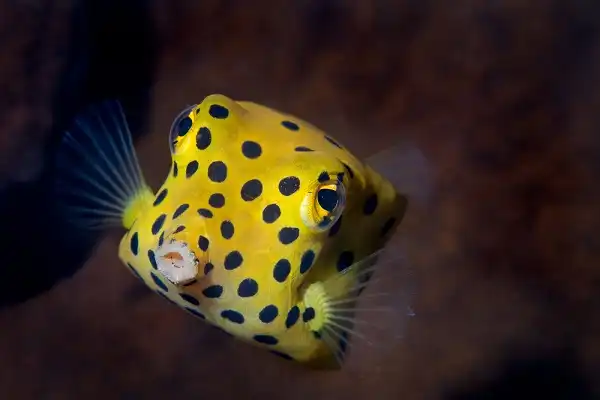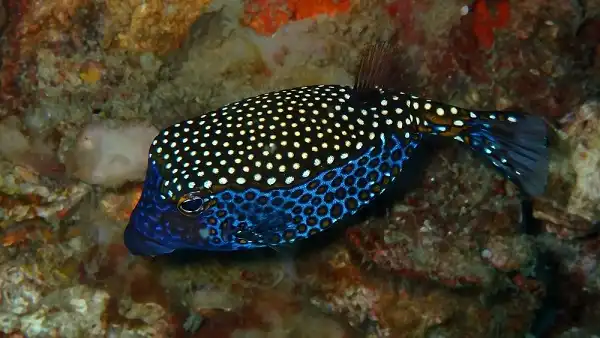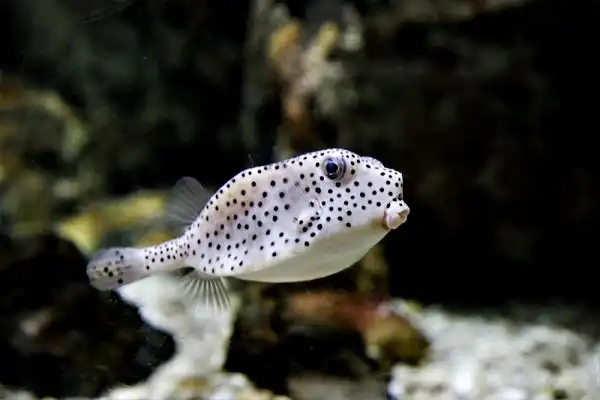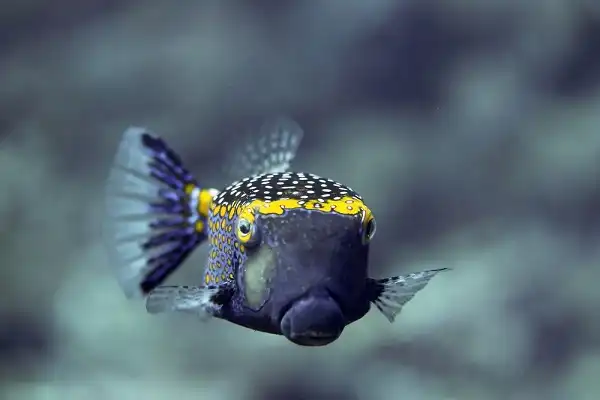Introducing the fascinating world of boxfish, a distinct species that is truly unlike any other! These curious creatures have captivated audiences around the globe with their brightly colored bodies and incredible ability to produce toxins. From their unique shapes to their remarkable survivability, there’s so much we can learn from Boxfish. Join us as we take an in-depth look into these amazing animals: exploring where they live, how they reproduce, and what sets them apart from other aquatic life. Dive into our comprehensive guide today—you won’t regret it!

Boxfish Description
Boxfish are an amazing species of fish that have some very unique physical characteristics. They have a flattened, box-like shape and can be found in a variety of colors including yellow, orange, red, white, and blue. Some even have intricate patterns on their bodies. These unique shapes help them to camouflage in their natural habitats and avoid predation. They have large heads with two slender dorsal fins on the top. Their eyes are positioned on either side of their heads and they are capable of producing toxins that protect them from predators. Boxfish also have strong tail fins which help them move quickly through the water.
Boxfish Habitat
Boxfish are found in a variety of tropical and subtropical waters around the world, including the Indian and Pacific Oceans, the Red Sea, and the Caribbean. They are typically seen inhabiting coral reefs or seagrass beds where they have plenty of cover from potential predators. They generally like to stay in depths ranging from 10 to 50 feet although they have been known to venture into shallower waters on occasion. Boxfish prefer warm, sandy areas that provide plenty of places for them to hide. These fish form small groups within their own species and often stake out an area as their territory which they fiercely protect from other intruders. Boxfish are also adept at using their flattened bodies to squeeze through tight crevices in search of food or shelter. In terms of actual behavior, boxfish tend to be quite active during daylight hours when they can take advantage of natural sunlight for hunting and resting. During nighttime, they will retreat to deeper waters where there is greater protection from predators. They also demonstrate strong homing tendencies; if moved away from their home location, a boxfish will often attempt to return back once released.
Boxfish Diet
Boxfish are omnivores that feed on a variety of organisms such as worms, crustaceans, and small fishes. They also scavenge for dead animals and plants as well as consume algae when available. Boxfish have specialized mouths with strong jaws that enable them to crack open shells to get to the tasty morsels inside. In order to extract the most nutrition from their food source, they often use their gill rakers to sift through sediment in search of small prey items. In addition to eating smaller animals, boxfish can also be seen feeding on larger creatures such as squid and octopus. Their large eyes help them to locate food sources in murky water and they will often make use of crevices or caves for shelter while hunting for prey.

Boxfish Size
Boxfish come in a wide range of sizes, with the smallest species reaching just 2 inches in length and the largest growing up to 24 inches. They have flattened bodies that allow them to easily squeeze through tight spaces and can reach up to 6 inches in depth. The shape of their bodies also helps them to move quickly through the water and evade predators. The size of a boxfish depends on its species as well as its age, gender, health, environment, and diet. Generally speaking, they are smaller when they are young and grow larger as they age; males tend to be bigger than females; and those kept in captivity may be larger due to better nutrition.
Boxfish Lifespan
Boxfish have relatively short lifespans compared to other species of fish, typically living for around 10 years. However, some species can live up to 20 years if they are properly cared for and provided with a suitable habitat. The exact lifespan of a boxfish will depend on its species, size, health, and environmental conditions. Most boxfish are considered to be mature at three or four years old and reach their maximum size by the age of five. As they grow older, they become more vulnerable to predators due to their slower swimming speeds and decreased agility. This is why it is important to provide them with plenty of hiding spots in their tank in order to protect them from potential danger. Overall, the exact lifespan of a boxfish will vary depending on its species and environment but most are expected to live between 10-20 years when given the proper care and attention. It is important for owners to create an environment that is conducive to long-term health so that their beloved boxfish can thrive for many years to come.
Boxfish Behavior
Boxfish behavior is largely determined by their habitats and the type of predators that they encounter. In general, boxfish are agile swimmers who use their flattened bodies to quickly dart away from danger. When threatened, they will often use their coloration to blend into their surroundings in order to avoid being detected. They can also increase the amount of distance between themselves and potential predators by executing sudden bursts of speed and changing directions erratically. Additionally, they may employ a variety of defensive techniques such as hiding in debris or burrowing into sand to evade detection. Overall, boxfish have an array of behaviors that help them survive in the wild. They are highly adaptable creatures who rely on camouflage, agility, and understanding of their environment to evade predators while also using active and passive hunting strategies to find meals throughout the day.

Boxfish Speed
Boxfish are known for their agility and swiftness in the waters. Their flattened bodies allow them to reach speeds of up to 10 mph while swimming, which is faster than many other species. This speed helps boxfish escape predators and hunt down prey that might be otherwise out of reach. They can also change direction quickly and execute sudden bursts of speed when necessary, which further increases their chances of survival. Some boxfish species are even capable of swimming in reverse, allowing them to surprise predators by quickly reversing away from danger instead of turning and running in the opposite direction. This added agility has allowed boxfish to become hunters as well as survivors in their ecosystems. Overall, boxfish have evolved to swim with remarkable speed and agility due to their flattened shape, allowing them to outrun predators or chase down prey with ease. This combination of speed and maneuverability has enabled them to survive in the wild for centuries despite competition from other aquatic species.
Boxfish Hunting
Boxfish use both active and passive hunting strategies to feed, based on the species they are. Active foraging involves actively pursuing food through swimming; whereas passive foraging consists of waiting in camouflaged locations until unsuspecting prey swims close enough for attack. Boxfish are agile swimmers who use their flattened bodies to quickly dart away from danger and can reach speeds of up to 10 mph while swimming. This speed helps them catch smaller creatures such as worms and crustaceans or larger prey like small fish and mollusks.
Boxfish Life Cycle and Reproduction
Boxfish have a unique life cycle that helps them survive in their aquatic environments. They begin as eggs, which are laid in shallow waters and take around 3-4 days to hatch. The larvae are then swept away by currents and begin their new life in the open sea where they will feed and grow for approximately 2 months before reaching adulthood. As adults, boxfish typically reach sexual maturity at around 2 years old but may take up to six or seven based on the species. With multiple breeding seasons throughout the year, boxfish have adapted to reproduce year-round when conditions are optimal. During the mating season, males will usually court several females by displaying brightly colored patterns along their bodies and engaging in elaborate displays of swimming behavior. Females will then lay anywhere from 5 to 50 eggs at a time depending on the species, often attaching them to hard surfaces such as rocks or coral reefs.

Boxfish and Human Interaction: Dangers and Precautions
Boxfish and humans can have interactions both beneficial and dangerous. While some species of boxfish may be kept in home aquariums as pets, there are a number of risks to consider. In the wild, boxfish are often sought after for their unique shape and color, making them desirable by collectors or tourists who may be unaware of the potential dangers this poses to both the boxfish and humans. For one, touching a wild boxfish can cause injury due to the sharp spines found along its body and fins. Additionally, many species contain a toxin known as tetrodotoxin which is highly poisonous and can be fatal if ingested. As such, it is important for those handling wild boxfish to take necessary precautions such as wearing protective gear, avoiding handling them with bare hands, and not consuming any part of the fish.
Conclusion
Boxfish are highly adaptable aquatic creatures that rely on their unique abilities to survive in the wild. Using a combination of speed, agility, and camouflage, boxfish can evade predators while also using active and passive hunting strategies to find meals throughout the day. This combination of strategies has allowed them to remain, successful hunters, as well as survivors in their ecosystems for centuries. With their remarkable traits and abilities, it is no wonder why boxfish have become such a beloved creature amongst nature enthusiasts all over the world.
Frequently Asked Question

